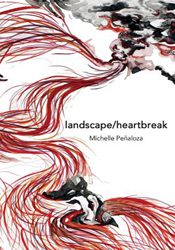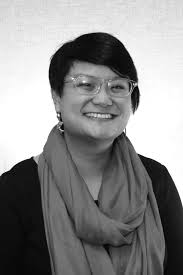
Michelle Peñaloza’s landscape/heartbreak is smooth, alluring, and warm. She is a writer’s writer. In landscape/heartbreak she does the hard physical work of walking the poem. To gather material for the chapbook, she walked 119 miles of Seattle with 22 people over the course of a year. The outcomes are these 16 forthright poems, the weft of her experiences, the warp of her walking partners’ stories. She starts by telling us this: “to travel by foot is to surrender. To the motion of your body alone.” Then; “Walking in a pair is a different kind of surrender. There is no particular lead or follow, but like dance partners, each person’s slight shifts signal without words […]”
Her ‘ask’ to her walking partners was – show me a place where you got your heart broken. And they walked together. They tell their stories and the poet listens – with skills she has honed over the years – skills she began to learn when, at 16, her father died in a car crash.
“I learned what not to say to someone feeling that kind of pain. Don’t say you understand.Don’t say everything is going to be okay. Do not ever say that things happen for a reason.Say nothing. Listen.”
This book confronts the clichés of loss. “We name our trauma in clichés. After all, what is the term “heartbreak” if not a cliché?” Michelle takes common words of grief and forges them into shared experiences of loss that are, somehow, as ordinary as they are transcendent. For instance, here, in “Pentimento,” where she collages stories from different conversations:
at 7-11, a woman molts her party dress for running shorts.
Still tottering on high heels, she cries as a man slips into
a cab, leaving her for the last time. Good riddance,
someone somewhere mutters. A door slams.
and later in the same poem:
A father is always never arriving. A son waits at the zoo.
A mother takes her son’s hand, points to the giraffes and otters.
In “We walk a heart around Lake Union,” she bores down on one experience, one walk where theheartbreak is mutual, a shared thing, a bond. She teaches the reader about each particular grief,everyday griefs that render so many blind and mute:
We’ve talked many times before about
what it means to be noticed, to be
threatening and invisible at the same time.
In this way, we are sisters. We stay close,
two brown women walking together.
[…]
This city does not want me.
What do we do when the ground we claim
as home changes beneath our feet?
 Towards the end of the book she includes two poems back to back that center on miscarriage and stillbirth, and teaches the reader the damage we can do through our silences, or our ill-conceived speech about others’ griefs. She zeroes in on the tension between three silences –the cowardice of being mute about the suffering of others, the inability to speak to other people’s grief, and the listener who truly hears, who honors our stories. For instance this, in “So much land, so few houses”:
Towards the end of the book she includes two poems back to back that center on miscarriage and stillbirth, and teaches the reader the damage we can do through our silences, or our ill-conceived speech about others’ griefs. She zeroes in on the tension between three silences –the cowardice of being mute about the suffering of others, the inability to speak to other people’s grief, and the listener who truly hears, who honors our stories. For instance this, in “So much land, so few houses”:When we say that we know, that we understand –
we lie. That is not to say we mean to, only we cannot
walk for long between the towns of grief where
other people sleep and do not breathe but can
find a road and a row of houses and there keep
safe the stories we cannot turn out into the night.
For me, the centerpiece of the book is “Remove all dads,” where the poet walks us through her own grief. It starts with: “Dying is such an irresponsible thing for a father to do.”
…we seek out the dad-shaped
holes to find in the world:
[…]
The atmosphere of every reading,
gallery opening,
graduation, school play
parent/teacher conference
feels drafty, a bit
windblown, what with all
the dad-shaped holes milling about.
This is a different silence, one that comes to us with loss, the confusion of things that are gone,silence where we expected words or actions. Here, the longing is so specific, for particular shared experiences. Shared, not only through walking together for an afternoon, but for a lifetime.




